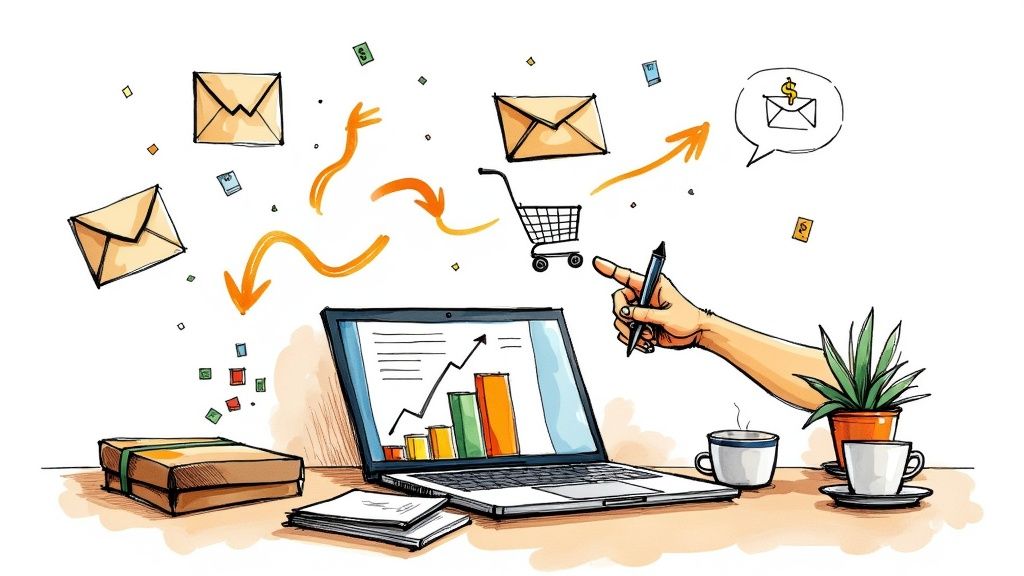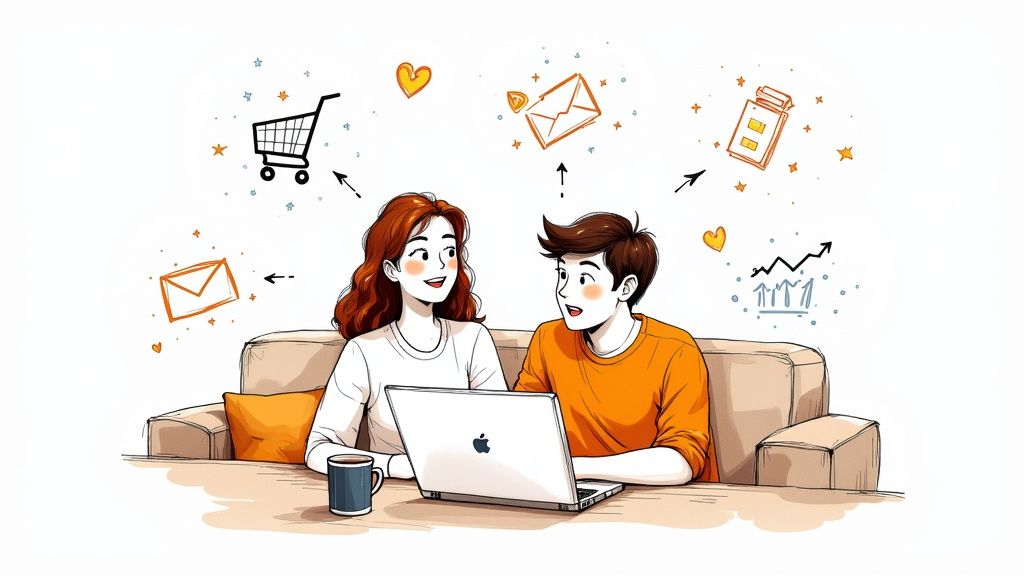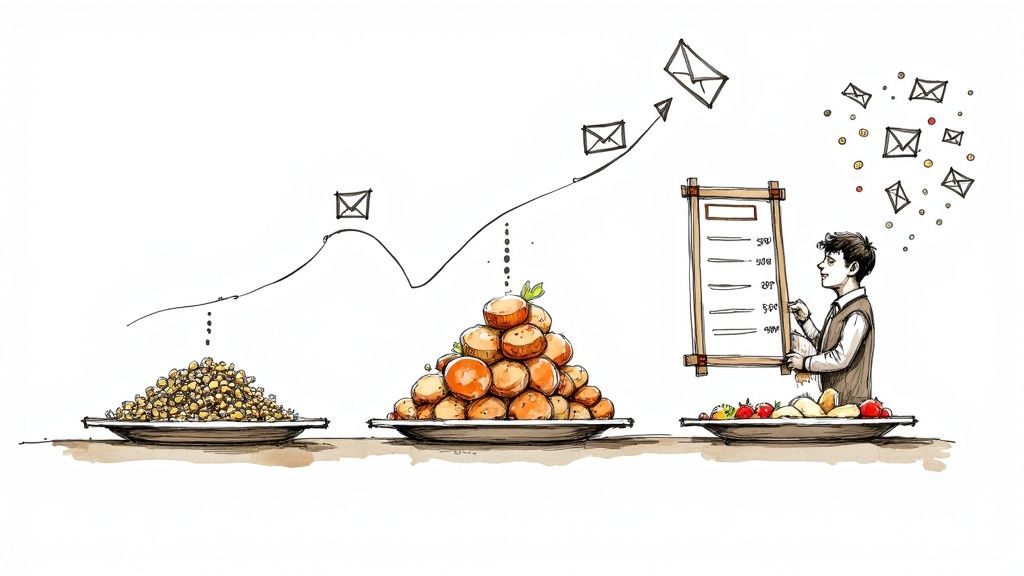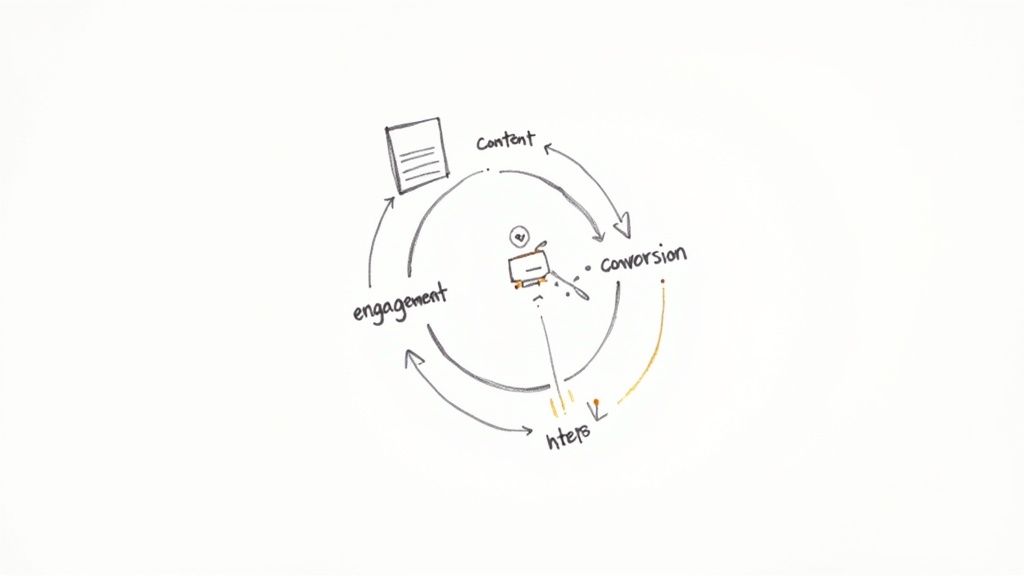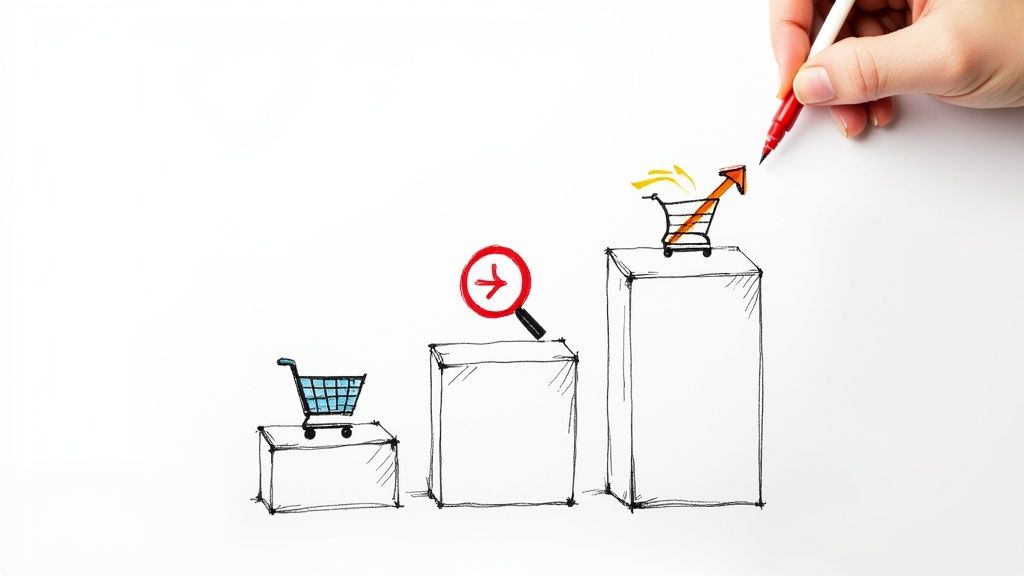Email Welcome Series Best Practices to Boost Engagement
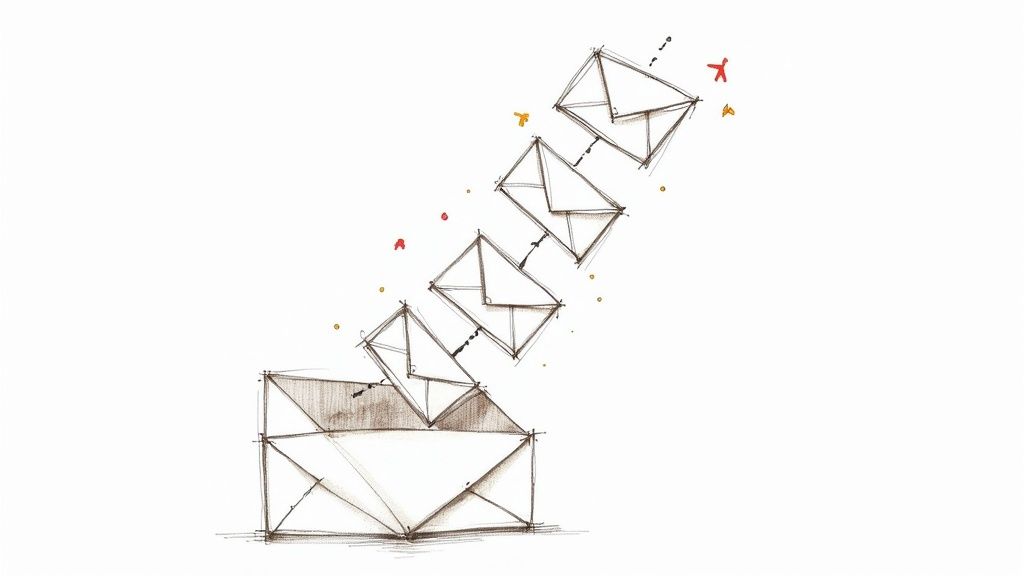
12 mins
5/25/2025
Joe Ervin
- email marketing
- welcome series
- email welcome series best practices
- email best practices
- customer retention
Welcome New Customers the Right Way
Want more repeat customers? A strong email welcome series is key. This article shares 7 email welcome series best practices to boost sales. Learn how to turn new buyers into loyal fans. We'll cover progressive value delivery, segmented personalization, multi-channel integration, behavioral trigger optimization, social proof, educational content, and mobile-first design. These simple tips will help you build trust and show value fast. If your brand earns over $500K a year, Trace Branding can help you build high-performing email flows.
1. Spread Out Value
Progressive value delivery makes your welcome emails better. Instead of giving all the good stuff at once, you spread it out. This keeps people interested and excited for the next email. They learn more about your brand bit by bit.
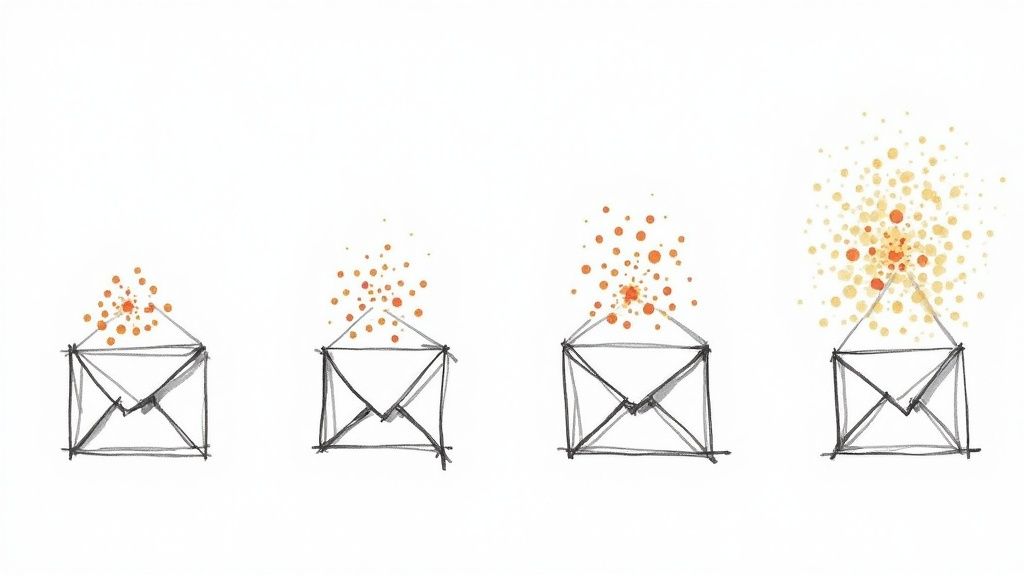
This method is key for a good email welcome series. It avoids overwhelming new subscribers. It also builds excitement and helps you learn what they like. Imagine getting a huge info dump in one email! Most people would delete it. Instead, give value slowly. Think of it like giving a delicious meal one course at a time.
Examples:
Spotify: They slowly introduce new music, app features, and paid options.
MasterClass: They show different classes and teachers in several emails.
Notion: They teach you how to use their workspaces and templates step-by-step.
Tips for Your Brand:
Plan it Out: Spread your best info across 5-7 emails.
Start Strong, Finish Stronger: Give some value right away, but save the best for emails 3-4.
Watch What Works: Use data to see what people like and adjust your email timing.
Tease the Next Email: Make people excited about what's coming!
Pros:
Keeps people reading your emails.
Fewer people unsubscribe.
Makes people excited for more.
Helps you learn what your subscribers want.
Cons:
Some people might lose interest if you wait too long.
You need to plan your emails carefully.
Sales might happen slower.
When and Why to Use It:
Spread out email value if you want to build a strong relationship with your subscribers. This approach works well for ecommerce brands, skincare brands, and clothing brands. These businesses often have a lot to share with new customers. You can space out details about your products, special offers, and brand story. This keeps your subscribers interested and eager to learn more. It's a smart way to turn new subscribers into loyal fans. Popularized by experts like HubSpot and ConvertKit, this approach is proven to work.
2. Segmented Personalization
Want to send emails your customers actually want to read? Use segmented personalization. This means creating different welcome emails based on what you know about your customer. Think about how they signed up, what they like, or what they've bought before. This way, every customer gets emails just for them. This makes them more likely to open, click, and buy! This strategy is a crucial element of email welcome series best practices.
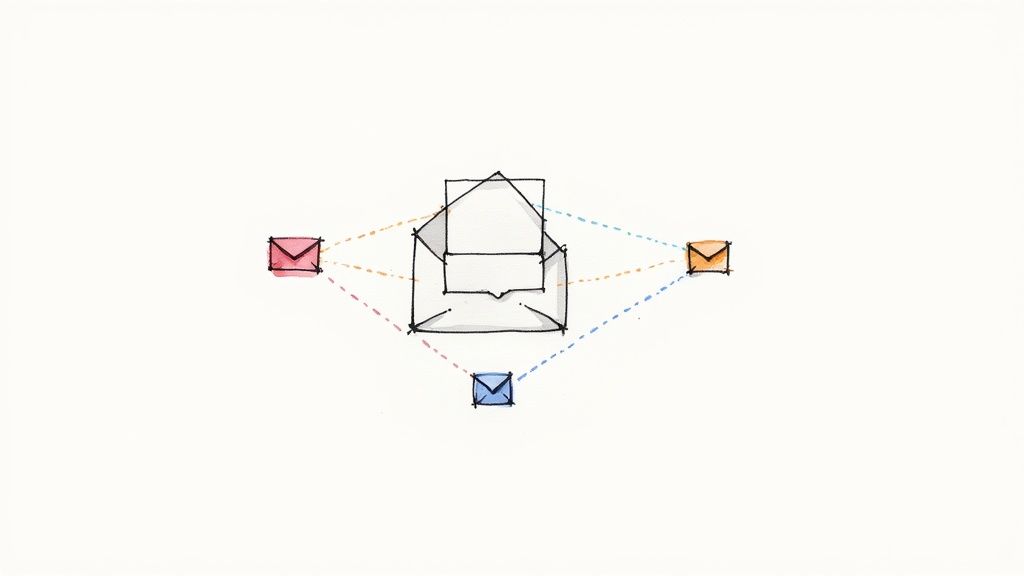
This approach uses special features to make your emails super relevant. Think dynamic content that changes based on customer data. You can create many welcome series versions. You can even trigger emails based on what customers do on your site. For example, someone who browses your face wash collection gets emails about skincare.
Think of it like this:
Airbnb: Sends different welcome series to people who rent homes (guests) and people who list homes (hosts).
LinkedIn: Welcomes new users with emails based on their job and field.
Shopify: Helps new store owners with emails based on their store type and size.
Good things about segmentation:
More people open and click your emails.
More people buy your products.
Customers are happier.
You learn more about your customers.
Things to watch out for:
You need good email software.
It takes more work to set up.
You need to write more emails.
Tips to get started:
Begin with just 3 or 4 customer groups.
Use signup forms to learn about your customers.
Test different emails to see what works best.
Keep learning more about your customers over time.
Why this matters:
A generic welcome email is like sending the same postcard to everyone on your mailing list. Segmented personalization, on the other hand, is like sending a handwritten letter. It shows you care. For ecommerce brands, skincare lines, and clothing stores, this personal touch boosts sales and builds strong customer relationships. It’s a key part of email welcome series best practices because it makes your welcome emails work harder for you. Tools like Mailchimp and Klaviyo, and experts like Ann Handley, have shown just how powerful this strategy can be.
3. Expiring Incentives
Want to make your email welcome series more effective? Use expiring incentives. If your welcome offer is a discount or some other perk, set it to expire. This adds urgency. Customers feel encouraged to act quickly.
Think of it this way: a simple discount is nice, but a discount that ends soon grabs attention. It makes customers think, "I need to use this before it’s too late." This creates excitement and pushes people to respond.
For example, imagine you receive an email offering 20% off, but only for the next 48 hours. You're more likely to use it quickly than if the offer lasts forever. This tactic is a great way to boost engagement because it motivates immediate action.
However, there are downsides. If incentives expire too quickly, customers might feel rushed. If they expire too slowly, urgency is lost. Finding the right balance is key.
Here are simple tips: Decide how long your offer should last before starting. Use clear messages to highlight the deadline. Limit how often you send these offers to avoid overwhelming customers. Track how well each incentive performs.
Big companies use this strategy effectively. Experts recommend it, too. This approach is useful for ecommerce brands, skincare brands, and clothing brands aiming to improve customer connections.
4. Behavioral Trigger Optimization
Behavioral trigger optimization makes your welcome emails smarter. It sends automated emails based on what your subscribers do (or don't do). This creates a welcome experience that feels personal. Think of it like a choose-your-own-adventure book for your emails. If a subscriber clicks a link about face cream, your next email shows them more face creams. If they don't open any emails, you send a different kind of email to try and get their attention. This method uses triggers like opens, clicks, purchases, and sign-ups to guide the subscriber journey.
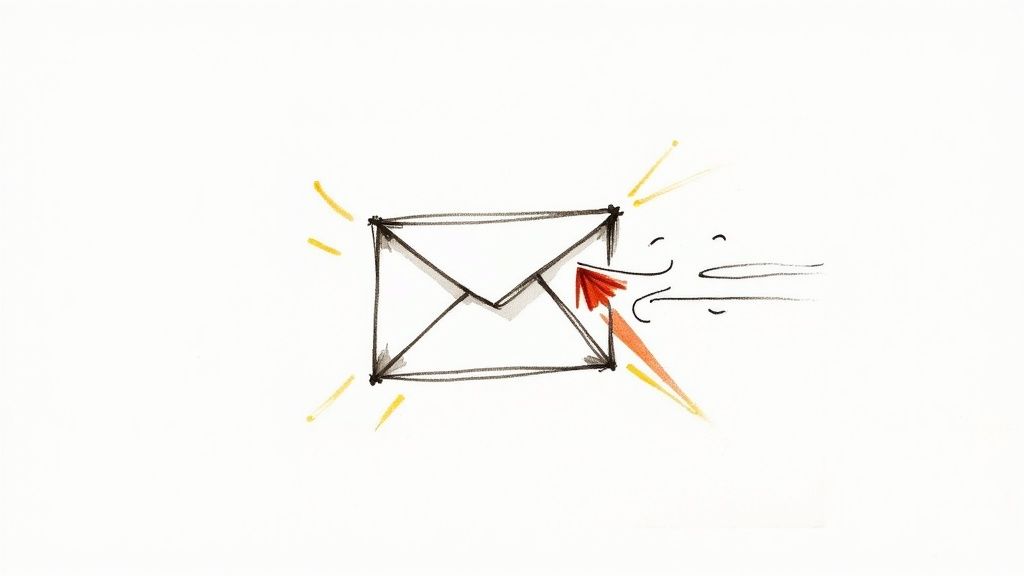
This approach is important for any email welcome series best practices because it boosts sales and makes customers happy. It helps you send the right message at the right time. For example, if someone adds a shirt to their online cart but doesn't buy it, an automated email can remind them and offer a small discount. This targeted follow-up often leads to more sales. Learn more about Behavioral Trigger Optimization
Real-time behavior tracking, automated responses, and engagement scoring make this possible. Features like abandoned cart recovery flows help you recapture lost sales. Think of Netflix. They suggest shows based on what you watch. Amazon does the same thing with products you view or buy. Headspace, a meditation app, changes your onboarding based on how much you meditate.
Tips for using behavioral triggers:
Start simple: Begin with email opens and clicks.
Re-engage: Send special emails to subscribers who haven't opened your emails.
Suggest products: Use data to show relevant items.
Avoid overload: Give subscribers breaks between emails.
Pros:
Relevant messages: Emails match subscriber interests.
More sales: Targeted follow-up works.
Automated management: Saves you time and effort.
Better use of resources: Focus on what matters.
Cons:
Needs special tools: You’ll need marketing automation software.
Can be complex: Takes time to set up and manage.
Privacy: Be mindful of customer data.
Behavioral trigger optimization is a powerful tool for ecommerce, skincare, and clothing brands. It takes your email welcome series to the next level. Using this method will improve your results and make your customers feel valued.
5. Social Proof
Social proof makes your welcome emails stronger. It shows new subscribers that others love your brand. This builds trust right away. This section explains how to use social proof in your email welcome series, making it one of the best practices for higher engagement and sales.
Social proof means showing how others enjoy your products. Think customer reviews, photos of people using your products, and stats about your happy customers. Adding these to your welcome emails makes new subscribers feel more confident about your brand. They see real people enjoying what you offer. This makes them more likely to buy from you.
Examples of Social Proof in Action:
Glossier: Shows customer photos and reviews in their welcome emails. New subscribers see real people using and loving Glossier products.
Coursera: Shares student success stories. New students see how others finished courses and reached their goals. This makes them feel encouraged.
Canva: Shows off amazing designs made by users. New users see what they can create, building excitement.
Why Use Social Proof?
Builds Trust: New subscribers trust what other customers say more than what your brand says.
Reduces Doubt: Seeing others happy with your product helps remove doubts a new subscriber might have.
Boosts Sales: Social proof makes people more likely to buy.
Features of Social Proof:
Customer stories: Share stories about how your product helped someone.
User content: Show photos and videos of people using your product.
Reviews: Share good reviews from happy customers.
Stats: Use numbers to show how many happy customers you have.
Pros of Using Social Proof:
Makes people trust you faster.
Gets rid of doubts.
Makes people buy more.
Makes people feel like they belong.
Cons of Using Social Proof:
You need to keep collecting new proof.
Old proof can become outdated.
You need permission to use customer content.
Tips for Using Social Proof:
Show a mix of people: Make sure your testimonials show different types of customers. This helps everyone in your target audience feel included. Think skin tones, ages, genders. Show diversity.
Use numbers: "9 out of 10 customers love our product" is stronger than "Lots of customers love our product."
Keep it fresh: Change the social proof you use often.
Get permission: Always ask before using a customer’s photo or words.
Who Made This Popular?
Brands like Warby Parker and Casper, along with tech companies like Zoom and Dropbox, use social proof well. Conversion expert Peep Laja also talks about the power of social proof.
Social proof is a key part of a great email welcome series. It quickly builds trust with new subscribers, turning them into loyal customers. By using these best practices, ecommerce brands, especially skincare and clothing brands, can greatly improve their customer relationships and sales.
6. Educational Content Sequencing
Educational content sequencing makes your welcome emails teach, not just sell. It gives new subscribers helpful tips and lessons about your products. This builds trust and helps them get the most from what you offer. Think of it like a mini-course delivered right to their inbox. This is a key email welcome series best practice.
This approach works by giving information step by step. First, you share simple ideas. Then, you move to more complex lessons. This helps people learn at their own pace. You're building their skills and showing them you're an expert. This helps turn new subscribers into loyal fans.
Think of HubSpot. They teach inbound marketing basics in their welcome emails. Mailchimp does the same for email marketing. Adobe sends tutorials about their creative software. These brands teach valuable skills. This makes customers happy and more likely to stick around. Learn more about Educational Content Sequencing.
Features of a good educational sequence:
Step-by-step lessons: Make learning easy to follow.
Helpful resources: Offer guides and FAQs for quick answers.
Fun learning activities: Use quizzes or videos to keep people engaged.
Pros:
Happy, loyal customers: People stay longer when they learn from you.
Expert status: You become the go-to source for information.
Fewer support questions: Teaching upfront prevents problems later.
Higher customer value: Educated customers buy more over time.
Cons:
Takes time to make: Creating good content requires effort.
Slower sales: Focusing on teaching might delay first purchases.
Needs updates: Information can get old, so you need to refresh it.
Tips for your welcome series:
Start simple: Begin with basic ideas. Move to harder ones later.
Give clear steps: Tell people exactly what to do.
Use different formats: Mix videos, images, and text to keep things interesting.
Link to products: Show how lessons connect to what you sell.
This method is perfect for e-commerce brands, whether you sell skincare, clothing, or anything else. Why? Because teaching your customers how to use and enjoy your products builds loyalty. It also reduces returns and customer service inquiries. Educated customers are happy customers. They are also more likely to become repeat customers. So, build trust and boost your brand by teaching something new.
7. Mobile-First Design Optimization
Your welcome emails must look great on phones. Why? Over 60% of people open emails on their phones. Mobile-first design means you design for phones first, then computers. This is a key best practice for email welcome series.
This approach uses responsive design. This means your email changes to fit any screen. It also means fast loading, big buttons, and easy-to-read text.
Why is this important for your welcome series? A good mobile experience makes people happy. Happy people click more. They buy more. More clicks and sales are good for your business. Whether you own an ecommerce, skincare, or clothing brand, this matters.
What does a mobile-first email look like?
Responsive Templates: These templates change to fit any screen size.
Big Buttons: Buttons are easy to tap with a finger. Aim for at least 44px.
Single Column: Text goes down in one column, like reading a book. This is easier on phones.
Small Images: Images are compressed so they load quickly.
Good Examples:
Starbucks: Big, tappable buttons make it easy to get your free coffee.
Uber: Simple design makes it easy to take your first ride.
Instagram: Clean, image-focused emails get you sharing photos fast.
Pros:
Happy customers.
More clicks and sales.
Emails reach the inbox more often.
Ready for the future of mobile.
Cons:
Fancy designs can be hard.
You need to test on many phones.
The computer version might not be as fancy.
Tips for You:
Use one column for text.
Make buttons at least 44px wide.
Keep subject lines short (under 30 characters).
Test your emails on lots of different phones and email apps.
Experts who use this:
Litmus
Email on Acid
Jason Rodriguez
Instagram
Snapchat
Mobile-first design is crucial for a successful email welcome series. Make it easy for your customers to engage with your brand, no matter what device they're using.
7 Best Practices Comparison Guide
Best Practice | ⭐ Effectiveness / Expected Outcomes | 🔄 Implementation Complexity | ⚡ Resource Requirements | 💡 Ideal Use Cases | 📊 Key Advantages |
|---|---|---|---|---|---|
Progressive Value Delivery | ⭐⭐ Maintains engagement, reduces unsubscribes | 🔄 Medium - careful content planning | ⚡ Moderate - content sequencing | Nurturing subscriber interest over time | Builds anticipation, better interest tracking |
Segmented Personalization Strategy | ⭐⭐⭐ High engagement & conversion rates | 🔄 High - requires segmentation setup | ⚡ High - multiple content paths | Tailored messaging based on user data | Improves retention, provides actionable data |
Multi-Channel Integration | ⭐⭐⭐ Increased visibility & consistent CX | 🔄 High - complex coordination | ⚡ High - tools & timing management | Brands with multi-touch onboarding journeys | Higher engagement, diversified message reach |
Behavioral Trigger Optimization | ⭐⭐⭐ Timely, relevant messaging, better conversions | 🔄 High - automated triggers setup | ⚡ High - tracking & automation | Real-time response to subscriber actions | Improved conversion, efficient lifecycle management |
Social Proof Integration | ⭐⭐ Builds trust and reduces skepticism | 🔄 Low-Medium - content curation | ⚡ Moderate - ongoing collection | Building credibility and social validation | Increases conversions, fosters community |
Educational Content Sequencing | ⭐⭐ Long-term engagement and brand authority | 🔄 Medium-High - content creation | ⚡ High - extensive materials | Onboarding requiring skill-building | Reduces support needs, boosts customer lifetime value |
Mobile-First Design Optimization | ⭐⭐ Higher engagement on mobile opens | 🔄 Medium - responsive design | ⚡ Moderate - design & testing | Mobile-dominant audiences | Better user experience, improved deliverability |
Build a Welcome Series that Works
These seven email welcome series best practices will help you connect with new subscribers. Use these tips to build a strong welcome series.
First, give value over time. Don't give everything away at once. Next, group similar shoppers. Talk to each group in a special way. Then, use more than just email. Think about SMS messages and other ways to reach people. Use what people do to send the right messages. Show how other people love your brand. Teach new customers about your brand and products. Make sure emails look good on phones.
Mastering these email welcome series best practices is key to success. A great welcome series makes more sales. It builds strong bonds with your customers. This makes customers more likely to buy again. For bigger e-commerce brands (over $500K in sales), Trace Branding can help. We build high-performing email flows, campaigns, and content.
Try these tips. Test what works. Build a welcome series that turns new shoppers into loyal fans.
